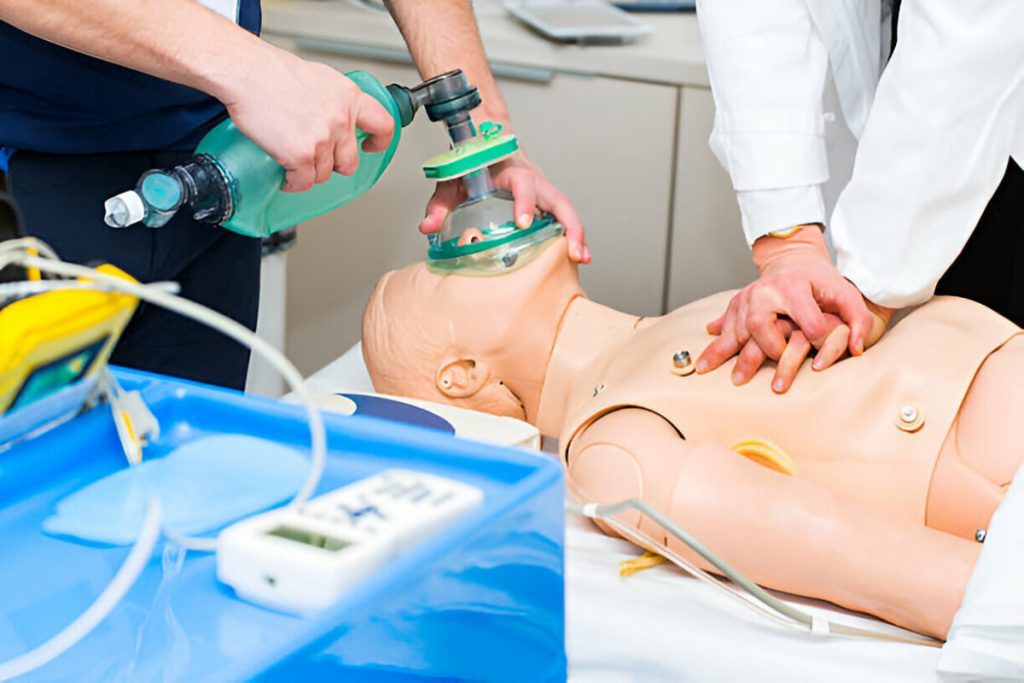When cardiac emergencies strike, every second counts. About 350,000 sudden cardiac arrests happen outside hospitals in the United States each year, with nearly 90% resulting in death without immediate help. Many people wonder whether their BLS certification covers first aid. The answer is crucial for healthcare professionals and first responders who need proper training credentials.
What BLS Training Actually Covers
The American Heart Association’s BLS course trains participants to recognize life-threatening emergencies, deliver high-quality chest compressions, provide appropriate breaths and ventilations, and use an AED early. The training reflects the latest science from the 2025 AHA Guidelines.
BLS certification focuses specifically on cardiovascular emergencies. It primarily maintains the ABCs – Airway, Breathing, and Circulation in critical situations. This includes CPR for adults, children, and infants, AED operation, and clearing obstructed airways.
First Aid in BLS Training: The Reality
Here’s the crucial distinction: BLS certification does not include first aid. While both aim to save lives, they serve different purposes and cover different medical situations.
BLS certification covers everything CPR classes include, but adds life-saving techniques for cardiac arrest, respiratory distress, or obstructed airways. However, standard BLS courses don’t teach treatment for minor injuries, burns, fractures, or other non-life-threatening conditions that fall under first aid.
Understanding First Aid in BLS Training Contexts
The term “first aid” is relatively broad, describing primary aid given to individuals suffering from both minor and life-threatening conditions. While CPR and BLS skills broadly fall into the first aid category, BLS and first aid should not be considered the same thing.
Some training providers offer combined courses. BLS training can be an extension to CPR and AED classes, with additional first-aid measures including protocols for wounds, burns, fractures, and poisonings. However, this is not standard in all BLS certifications.
Who Needs BLS Versus First Aid Certification?
Healthcare Professionals Need BLS
The BLS Provider Course is designed for healthcare professionals and trained first responders who provide care in a wide variety of settings, as well as individuals in healthcare training programs. This includes:
- Doctors and nurses
- EMTs and paramedics
- Dental professionals
- Physical therapists
- Healthcare students
- Home health aides
General First Aid Training Suits Others
For teachers, childcare providers, or senior caregiver members, CPR and First Aid certification is best. First aid training covers everyday emergencies like cuts, sprains, burns, and choking that don’t involve cardiac arrest.
The Science Behind BLS Effectiveness
Research demonstrates BLS training saves lives. In a 2024 study, BLS-trained individuals delivered over 90% correct chest release, a skill that directly saves lives. Quick action matters because brain injury can start as early as 4 minutes without oxygen, and irreversible damage may occur within 6–10 minutes.
When BLS is performed, survival chances can double or even triple. This dramatic improvement comes from maintaining blood flow and oxygen to vital organs until advanced medical help arrives.
Key Components of First Aid in BLS Training Programs
While standard BLS focuses on cardiovascular emergencies, comprehensive training often includes:
Core BLS Skills:
- High-quality chest compressions
- Rescue breathing techniques
- AED operation
- Airway management
- Team-based resuscitation
- Opioid overdose response
Separate First Aid Skills:
- Wound care and bandaging
- Burn treatment
- Fracture stabilization
- Bleeding control
- Shock management
- Environmental emergencies
BLS Certification Requirements and Renewal
Upon successful course completion, students receive a course completion eCard, valid for two years. Healthcare facilities typically require current BLS certification for employment and credentialing.
The certification process involves both knowledge assessment and hands-on skills demonstration. BLS certification requires hands-on CPR skills demonstration and testing, ensuring providers can perform effectively in real emergencies.
Making the Right Training Choice
Your profession determines which certification you need. BLS certification is generally geared toward healthcare workers and first responders, including doctors, nurses, EMTs, paramedics, and other medical professionals.
Consider combined training if your role requires both skill sets. Many training centers now offer courses that integrate BLS with first aid, providing comprehensive emergency preparedness.
The Evolution of BLS Standards
The 2025 guidelines reviewed all relevant AHA Guidelines for CPR and ECC and publications from the International Liaison Committee on Resuscitation from 2020 through 2024. These updated standards ensure training reflects the latest scientific evidence.
Staying current with these guidelines is essential. Regular certification renewal keeps your skills sharp and aligned with best practices that improve patient outcomes.
Frequently Asked Questions
Q: Does BLS certification include CPR?
Yes, CPR is a core component of BLS training. BLS certification covers CPR for individuals suffering from cardiac emergencies, but it’s more in-depth than typical CPR courses. BLS emphasizes team dynamics and includes advanced ventilation techniques not taught in basic CPR classes.
Q: Can I use BLS certification instead of first aid certification for work?
Not always. You should confirm whether first aid training is required in addition to standard BLS training for your profession. Many employers outside healthcare require separate first aid certification to cover non-cardiac emergencies.
Q: How long does BLS training take?
Most BLS courses require 2-4 hours of instruction, combining online learning with hands-on practice. The Association offers full classroom courses or blended learning options combining HeartCode BLS with hands-on skills sessions. This flexibility allows you to complete the cognitive portion online before attending practical training.
Q: Is first aid in BLS training sufficient for workplace emergencies?
It depends on your work environment. While BLS prepares you for cardiac emergencies, workplace safety often requires broader first aid knowledge for injuries, burns, and other common incidents. Check your employer’s specific requirements to ensure compliance.
Take Action: Get Certified Today
Don’t wait for an emergency to realize you need proper training. Whether you’re a healthcare professional or someone who wants to be prepared, having the right certification can mean the difference between life and death.
Ready to get certified? CPR Cincinnati, an American Heart Association training site, offers comprehensive BLS classes in Cincinnati and CPR certification in Cincinnati. Our stress-free, hands-on courses include initial certifications and renewals in BLS for Healthcare Providers, ACLS, PALS, and CPR and First Aid courses.
Contact CPR Cincinnati today to enroll in upcoming courses and gain the confidence to respond effectively in emergencies. Your training could save a life.





